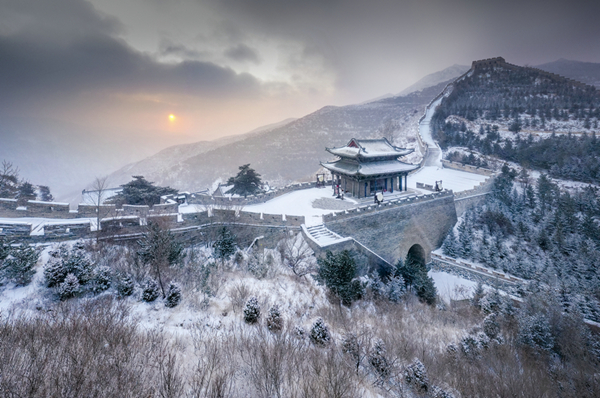Yanmen Pass

The Yanmen Pass. [Photo by Yang Dong, provided to chinadaily.com.cn]
Yanmen Pass, situated in the Yanmenshan Mountain approximately 20 kilometers north of the urban area of Daixian county, Xinzhou city, Shanxi province, stands as a vital stronghold of the Great Wall in ancient China. Famous for its steep terrain, Yanmen Pass is hailed as "No 1 Pass of China" and is often referred to as one of the "Three Outer passes" along with Ningwu Pass and Pianguan Pass.
The fortification of Yanmen Pass, built along the contours of the mountains, spans over 5 kilometers. At the southern terminus of the city wall, it links up with the eastern and western wings of the pass. Towards the north, the wall extends along the mountain ridge, down to the valley floor, effectively forming an enclosure with a gate. Beyond the enclosure, three large stone walls and 25 small stone walls serve as additional defensive barriers.
To the north of the pass, atop the hill, lie the remains of barracks used by Ming (1368-1644) and Qing (1644-1911) soldiers. In the southeast stands a training ground, while the west gate hosts the Guan Yu Temple. Outside the east gate lies the Jingbian Temple, which was built to pay tribute to Li Mu, a famous general in the Warring States Period (475-221 BC). The Jingbian Temple retains only stone tables, stone lions, stone flagpoles and several stone carvings from the Ming and Qing dynasties.
The ancient pass located west of the Yanmen Pass is commonly known as Tieli Gate. The two passes were connected by the stone-built Great Wall and watchtowers and beacon towers were constructed, forming a solid defense system. Near the ancient pass, there is a section of Baicaokou Great Wall built during the Ming Dynasty, which is one of the best-preserved sections of the Great Wall in China. This section measures 5033 meters in length, with walls standing 6 to 8 meters high, a bottom width of 5 meters and a top width of 3 meters. At intervals of approximately 120 meters, a beacon tower and a watchtower were built and in critical points, forts, trenches and hidden gates were constructed. The Baicaokou Great Wall eventually connects to the outer Great Wall after extending northward from both its eastern and western ends.
Knife Testing Rock
Seven kilometers north of Yanmen Pass, on the way south of Shidaoshi village, there is a rock with a massive knife mark engraved on its surface.
Ma's Tiger Slaying Place
Ma was an official responsible for the defense of Yanmen Pass during the Ming Dynasty. In ancient times, tigers frequently appeared along the passageway of Yanmen Pass, posing a threat to local people. Ma’s younger brother, out of concern for the welfare of the people, volunteered to eliminate the tiger threat, but fell victim to the beast. Devoted to achieving his brother's goal, Ma eventually killed the tiger, restoring peace and tranquility to the passage of Yanmen Pass. In honor of Ma's courageous act, local people donated funds to erect a memorial stone named "Ma's Tiger Slaying Place", and buried Ma's younger brother on the side of the memorial.
Yanjing Archway
Yanjing Archway, built during the Ming Dynasty, was originally a wooden structure. It was destroyed by Japanese soldiers during the War of Resistance against Japanese Aggression (1931-45). Now the original site has been restored to a white marble archway with stone pillars, stone arches and eight pillars with double eaves, with majestic shape and exquisite carving technology.



